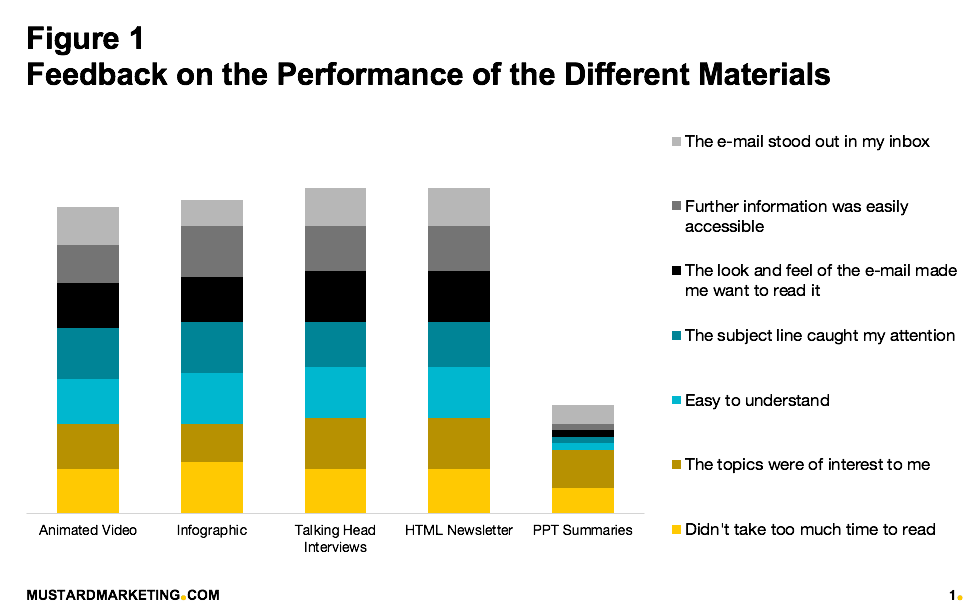Editor’s note: Lucy Davison is founder and managing director of Keen as Mustard, a London-based marketing agency.
 A strategy and insight client once said to me that her biggest problem was not finding data or insights, putting a team together or understanding customers, it was getting her internal stakeholders to pay attention to the work of her team. As she said at the time, “They never, ever, read the e-mail.”
A strategy and insight client once said to me that her biggest problem was not finding data or insights, putting a team together or understanding customers, it was getting her internal stakeholders to pay attention to the work of her team. As she said at the time, “They never, ever, read the e-mail.”
This is a constant challenge for insight teams. Right now, we all have too much data and information. Getting it is not the problem. The problem is to curate, package, target or communicate it to different internal audiences. At my agency we work with many companies who are brilliant at their customer marketing, but struggle with their internal communications. These are skills that researchers need to learn because if the value of the work we do lies in how well it influences our organization, how we communicate it is more important than ever.
Imagine the benefit to you and your organization if the insights and data you have were sought after and acted on, if you were a team of trusted advisors within the business with increased budget and a strong influence on the strategic plan. Imagine you have created a customer-driven culture in your company. This is the goal. And it is achievable.
Here are a few of our learnings from working with clients on their communication challenges. The road to overcoming your communication nightmares starts here.
1. Invest in your skills and knowledge.
Consider how much your organization spends overall on getting data and doing research, and then how much you spend on the communication of it. What proportion of your investment in the voice of the customer should you put into ensuring that your organization is using and acting on it? Bear in mind, a knowledge management system is not a communication solution. If you were to get 20% more exposure or traction internally, what would that be worth to you? Set a budget.
Then you need someone whose role it is to work on your communications, at least some of the time. Work out who in your team has the right skills, knowledge or experience, or if none of the above, who is a good natural communicator and could be trained and motivated? You can always ask someone to try internal comms on for size. One of our clients appointed a researcher to help on an internal comms project and the results were so effective, and she enjoyed it so much, that it became her full-time job.
If you don’t have the skills or experience within your team, work out who you need to recruit. Finally, don’t forget you might have a good internal comms team … why not reach out to them to help you?
2. Know your audience.
Rule No. 1 of good communication is understand your audience. Bear in mind that most people we are reaching out to think they do not have time and ignore most of the information they are given. We are competing with the information overload of modern life, not only business messages. It is important to understand your internal audience and segment them – as you would your consumers or customers.
Can you answer the following questions: Who do you most need to influence? What do they know about your department insights/data/you/your job? Are they interested? What do they pay attention to? Work out how best to reach them. Know the sort of people who will lean in – influencers, the people who understand and value insights so you can get a real sense of who you should be targeting. Which teams and departments are on board and can spread the word?
If you do not know the answers to all these questions, do your research! It has always struck me as surprising how little research researchers do on themselves. Then establish some benchmarks. What is it you want to achieve? Set realistic SMART objectives, share and track against them.
When we did a project with Coca-Cola Western Europe a few years ago, we segmented the audience for the strategy and insights team. The first group were the project stakeholders who were often commissioning research. They were well engaged with the work of the team, as they needed to act on the information and their KPIs often depended on it. They were well engaged when it was their project we were talking about. However, they were not engaged when it was not their project. So, they were not able to acquire broader knowledge about their customers. This sometimes led them to ask for new research when the insights team already had the information.
Then we had the C-suite. Begonia Fafian, the head of insights for Coca-Cola in Western Europe did a fantastic job of direct communication with them. They only needed a part of the information provided by the insights team, but what they needed was delivered really well, so we did not need to prioritize them for our campaigns.
We found that the problem was with the wider organization. These were the people who needed to act on the decisions made based on consumer insight, but often knew next-to-nothing about the consumer. Even worse, our initial research showed they did not think it mattered to them. They were several thousand people across multiple departments and markets. So, if Coca-Cola was to be the most consumer-driven organization in the world, these were the people we needed to connect with.
3. Have (the right) plan.
It is better to do one thing well than 10 things badly, so identify the one focus that will give the most value. It is always better to share less than more. For example, at the start of lockdown one client started scouring the news and doing a weekly round-up newsletter using published data and sharing it with the marketing team. This one initiative did more to raise the profile of the insights team than all their previous efforts in launching and communicating major studies they had commissioned themselves.
Think about different methods you have to communicate your insights – above all, do not rely on the PowerPoint report. A good plan is a mix of infographics, newsletters, videos, white papers, blogs, events, posters and posts. The chart below shows the impact of different content we created for Coca-Cola.

To make your plan effective, take findings from your research and define different audiences, the messages that are most pertinent to them and the methods and channels which will have the greatest impact.
4. Now, create your content.
For every different element when you are creating content, you must tell a story and stay really focused on what your core message is.
Here are a couple of ways we make sure we get our messages right and create content that resonates.
The first is to define your tone of voice. How do you want people to think of your team?
The way you communicate, both in terms of your methods or channels and the words and images you use, tell people something about you. So, establish how you want people to think about you and communicate your tone of voice so that anyone creating content knows what it is.
Second, you must define the single, overriding message that you want to get across. What is the one thing you want people to know? If they were to repeat to someone else what you had communicated to them, what do you want them to say? If you cannot articulate this in a single sentence, then work at it again until you can. Like most creative agencies we find it really helps to use a creative brief to do this. A brief is called a brief for a reason. It should be properly short (or, well, brief) two sides at most, and capture all the key information in language a layperson would understand.
This then helps you to focus and keep it short when you create your content. My experience in research and insights has taught me that many researchers don’t know the meaning of brevity. Based on our research, this is what we recommend – headlines, subject lines and titles of three to eight words, introductory text of 25 – 40 words, if you are sharing stories in a newsletter or infograph, limit the number to five, keep videos to two and a half minutes or under. Finally, it is vital that your content has a call-to-action – you must explain why people are getting the communication, what action do you want them to take, why is it for them.
In many companies the insight people are still e-mailing PowerPoint reports. They don’t help themselves by using a terminally boring subject line (“Q4 tracking results US/G/Fr,” or “H2 feedback on CX study (attached)” are two that spring to mind). By simply using that all important e-mail subject line in a more interesting way, we can entertain or engage our recipient to read on. In terms of titles, slides and in some cases, overall structure, very few reports we see start their story with the title or a good headline. We looked at a study which analyzed the content of 69,907 headlines produced by four major global media corporations during eight consecutive months. They came up with five types of headlines that attracted most clicks – surprise, curiosity, question, negativity, number (preferably an odd number). We use these all the time in our e-mail subject lines, report titles, slide titles and all manner of content.
5. Elevate and inspire.
Finally, commit, do it, experiment, try different things, test, measure, pilot and use your learning ongoing to build the most dynamic and impactful communications you can. A lot of clients spend months getting everything perfect. I’d say 80% done is better than perfect on the drawing board. Embrace failure, don’t expect it to be perfect first time but do serve up delicious dishes to your audiences – and keep trying.
